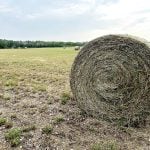MarketsFarm — Despite projections that Canada will have a large wheat harvest this year, Western Canadian wheat bids were mixed for the week ended Thursday, largely due to a weakening Canadian dollar.
Statistics Canada (StatCan) on Monday released its satellite imagery-based July principal field crop production estimates, which projected a total wheat harvest of 34.6 million tonnes. The figure is 55.1 per cent higher than that of the drought-stricken 2021 crop. Spring wheat production increased by 57.3 per cent to 25.57 million, while durum production more than doubled at 6.47 million.
The U.S. spring wheat harvest is more than halfway complete while also showing the potential for good yields after the U.S. Department of Agriculture (USDA) rated the crop 68 per cent good to excellent on Aug. 29, four points higher than expected. Beneficial rains in the U.S. southern Plains and warm, sunny weather in Western Canada are also adding to pressures.
Read Also

Pulse Weekly: Yields coming into focus
Provincial agricultural departments are reporting pulse yields higher than Statistics Canada’s September estimates.
However, the Chicago Board of Trade (CBOT) wheat markets took direction from choppy trade in the corn and soybean markets during the week, while the loonie fell by more than a U.S. cent to hit a 22-month low. Worldwide wheat supply concerns and uncertainty over Ukrainian grain shipments also provided support.
Canada Western Red Spring (CWRS, 13.5 per cent protein) wheat prices declined by 60 cents to $4.90 per tonne, according to price quotes from a cross-section of delivery points compiled by PDQ (Price and Data Quotes). Average prices were between $371.50 in southeastern Saskatchewan and $392.40 in southern Alberta.
Quoted basis levels ranged between $45.80 and $66.70 above the futures when using the grain company methodology of quoting the basis as the difference between U.S. dollar-denominated futures and Canadian dollar cash bids.
Accounting for exchange rates and adjusting Canadian prices to U.S. dollars, CWRS bids were from US$282.20 to US$298 per tonne. Currency-adjusted basis levels ranged from US$27.70 to US$43.60 below the futures. If the futures were converted to Canadian dollars, basis levels would be $21 to $33.10 below the futures.
Average Canada Prairie Spring Red (CPSR, 11.5 per cent protein) prices gained $2.80-$11.50 per tonne. The lowest average bid for CPSR was $348.30 in southeastern Saskatchewan, while the highest was $369.10 in southern Alberta.
Meanwhile, average Canada Western Amber Durum (CWAD) prices were down $7.10-$13.70 per tonne with bids ranging from $392.60 in southeastern Saskatchewan to $409 in southern Alberta.
The December spring wheat contract in Minneapolis, off of which most CWRS contracts in Canada are based, was quoted at US$8.8625 per bushel on Thursday, 9.5 U.S. cents lower than the previous week.
Kansas City hard red winter wheat futures, traded in Chicago, are more closely linked to CPSR in Canada. The December K.C. wheat contract was quoted at US$8.68/bu., up 1.75 U.S. cents.
The December Chicago Board of Trade wheat contract gained 5.25 U.S. cents from the previous week at US$7.9425/bu.
The Canadian dollar fell 1.35 U.S. cents from the previous week to close Thursday at 75.95 U.S. cents.
— Adam Peleshaty reports for MarketsFarm from Stonewall, Man.
















